climate control CHEVROLET PRIZM 1998 3.G Owners Manual
[x] Cancel search | Manufacturer: CHEVROLET, Model Year: 1998, Model line: PRIZM, Model: CHEVROLET PRIZM 1998 3.GPages: 364, PDF Size: 18.79 MB
Page 102 of 364
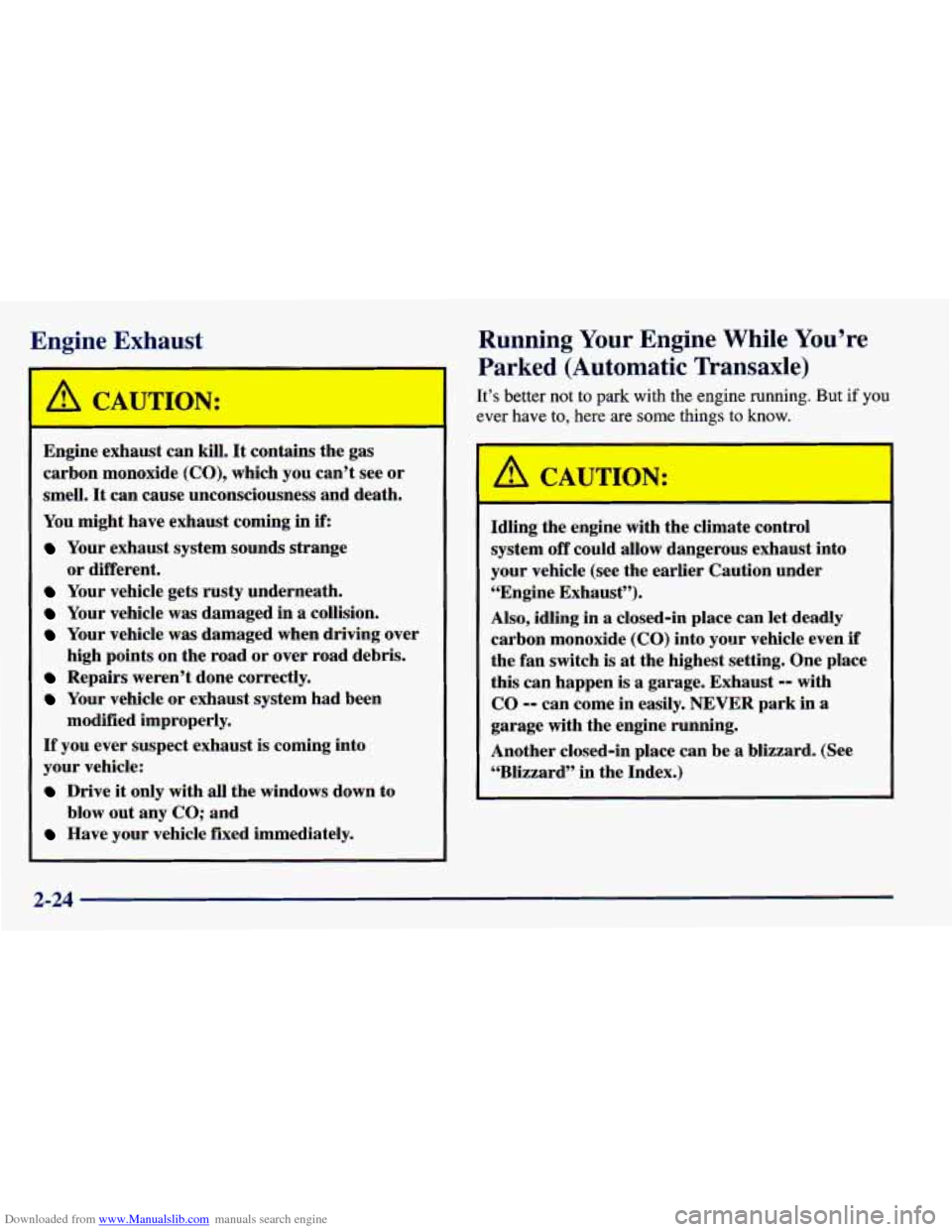
Downloaded from www.Manualslib.com manuals search engine Frgine Fvhaust
Engine exhaust can kill. It contains the gas
carbon monoxide
(CO), which you can’t see or
smell.
It can cause unconsciousness and death.
You might have exhaust coming in
if:
Your exhaust system sounds strange
Your vehicle gets rusty underneath.
Your vehicle was damaged in a collision.
Your vehicle was damaged when driving over
high points on the road
or over road debris.
Repairs weren’t done correctly.
Your vehicle or exhaust system had been
If you ever suspect exhaust is coming into
your vehicle:
Drive it only with all the windows down to
Have your vehicle fixed immediately.
or
different.
modified improperly. blow out any
CO; and
Running Your Engine While You’re
Parked (Automatic
Transaxle)
It’s better not to park with the engine running. But if you
ever have to, here are some things to know.
Idling the engine with the climate control
system
off could allow dangerous exhaust into
your vehicle (see the earlier Caution under
“Engine Exhaust”).
Also, idling in a closed-in place can let deadly
carbon monoxide
(CO) into your vehicle even if
the fan switch is at the highest setting. One place
this can happen
is a garage. Exhaust -- with
CO -- can come in easily. NEVER park in a
garage with the engine running.
Another closed-in place can be a blizzard. (See
“Blizzard” in the Index.)
2-24
Page 136 of 364
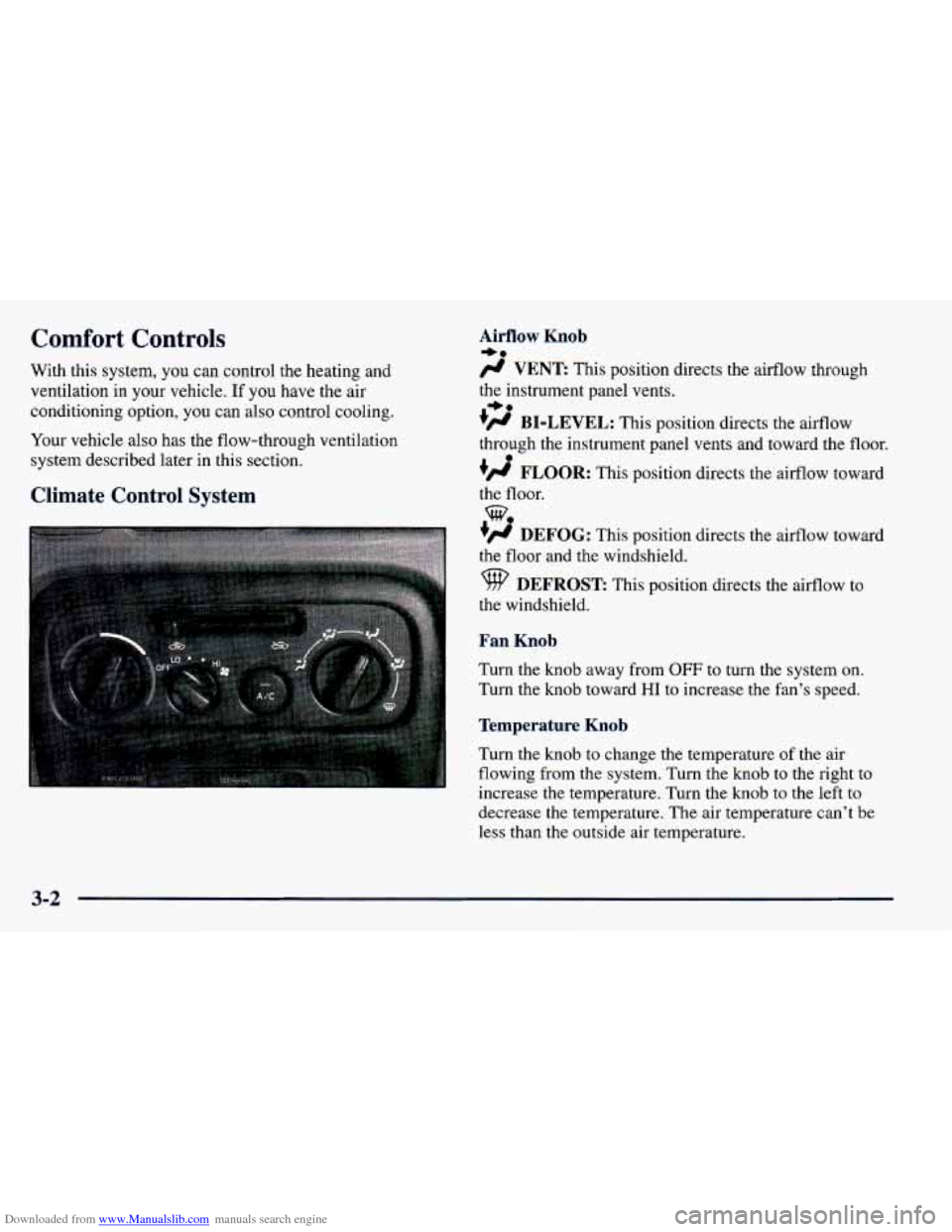
Downloaded from www.Manualslib.com manuals search engine Comfort Controls
With this system, you can control the heating and
ventilation in your vehicle.
If you have the air
conditioning option, you can also control cooling.
Your vehicle also has the flow-through ventilation
system described later in this section.
Climate Control System
Airflow Knob
/J VENT This position directs the airflow through
the instrument panel vents.
+’ BI-LEVEL: This position directs the airflow
through the instrument panel vents and toward the floor.
#’ FLOOR: This position directs the airflow toward
the floor.
+# DEFOG: This position directs the airflow toward
the floor and the windshield.
9 DEFROST: This position directs the airflow to
the windshield.
Fan Knob
Turn the knob away from OFF to turn the system on.
Turn the knob toward
HI to increase the fan’s speed.
Temperature Knob
Turn the knob to change the temperature of the air
flowing from the system. Turn the knob to the right to
increase the temperature. Turn the knob to the left
to
decrease the temperature. The air temperature can’t be
less than the outside
air temperature.
+e
+e
e
we
3-2
Page 137 of 364
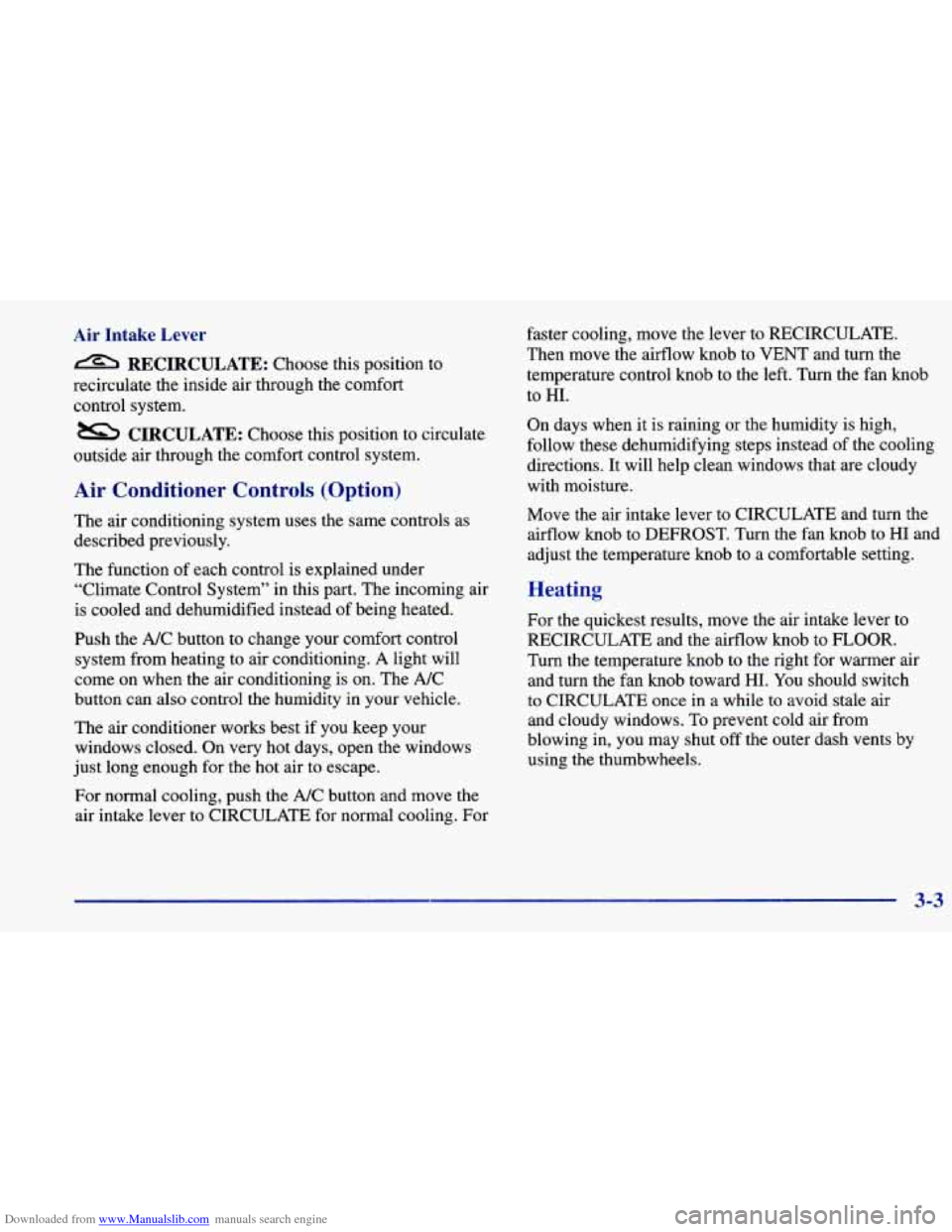
Downloaded from www.Manualslib.com manuals search engine Air Intake Lever RECIRCULATE:
Choose this position to
recirculate the inside air through the comfort
control system.
outside air through the comfort control system.
CIRCULATE: Choose this position to circulate
Air Conditioner Controls (Option)
The air conditioning system uses the same controls as
described previously.
The function of each control is explained under
“Climate Control System” in this part. The incoming air
is cooled and dehumidified instead of being heated.
Push the NC button to change your comfort control
system from heating to air conditioning. A light will
come on when the air conditioning is
on. The NC
button can also control the humidity in your vehicle.
The air conditioner works best if
you keep your
windows closed. On very hot days, open the windows
just long enough for the hot air
to escape.
For normal cooling, push the A/C button and move the
air intake lever
to CIRCULATE for normal cooling. For faster cooling, move
the lever to RECIRCULATE.
Then move the airflow knob to VENT and turn the
temperature control knob to the left. Turn the fan knob
to HI.
On days when it is raining or the humidity is high,
follow these dehumidifying steps instead of the cooling
directions. It will help clean windows that are cloudy
with moisture.
Move the air intake lever to CIRCULATE and turn the
airflow knob to DEFROST. Turn the fan knob to
HI and
adjust the temperature knob to
a comfortable setting.
Heating
For the quickest results, move the air intake lever to
RECIRCULATE and the airflow knob to FLOOR.
Turn the temperature knob to the right for warmer air
and turn the fan knob toward
HI. You should switch
to CIRCULATE once in a while to avoid stale air
and cloudy windows. To prevent cold air from
blowing in, you may shut
off the outer dash vents by
using the thumbwheels.
3-3
Page 267 of 364
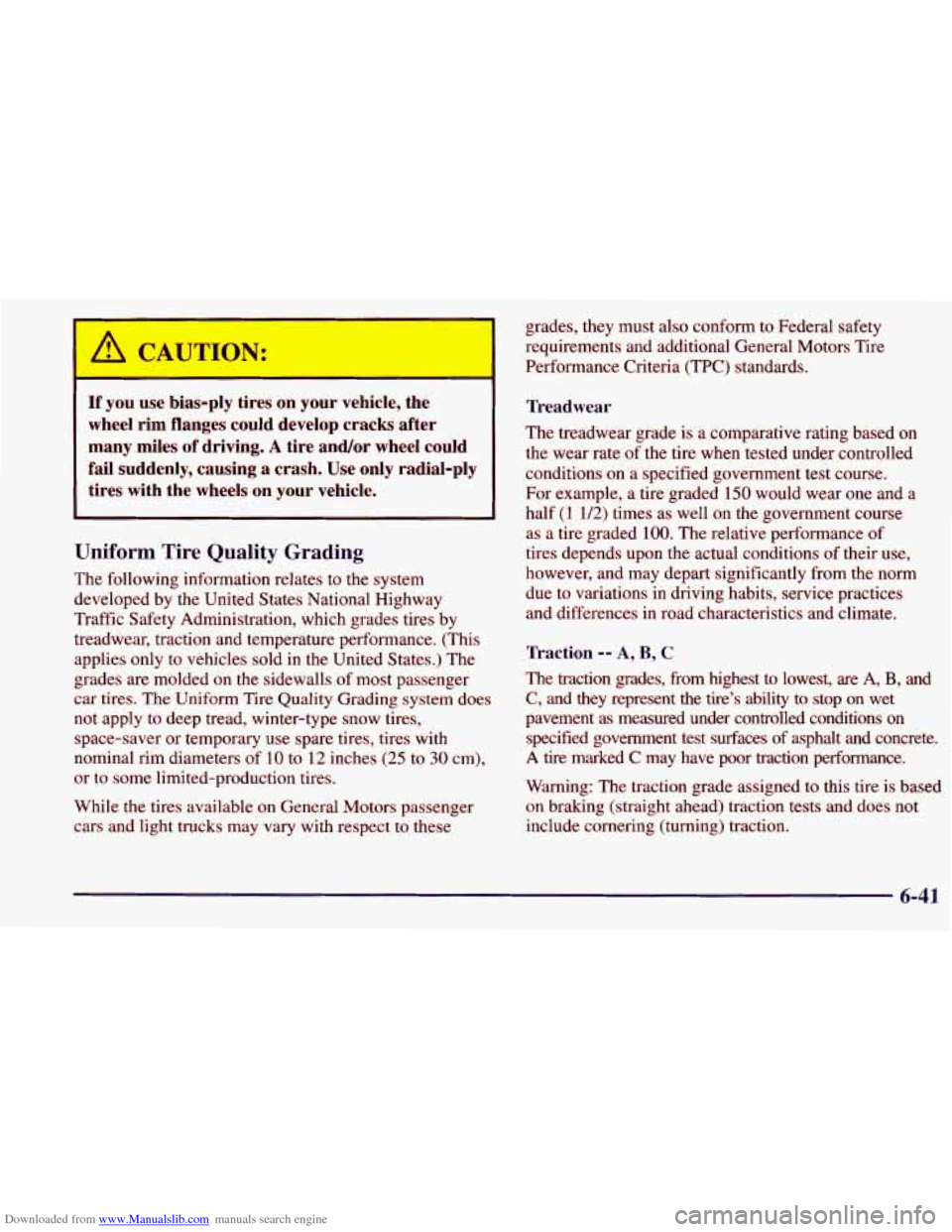
Downloaded from www.Manualslib.com manuals search engine I
A CAUTION:
If you use bias-ply tires on your vehicle, the wheel rim flanges could develop cracks after
many miles of driving.
A tire and/or wheel could
fail suddenly, causing a crash. Use only radial-ply tires with the wheels on
your vehicle.
I
Uniform Tire Quality Grading
The following information relates to the system
developed by the United States National Highway
Traffic Safety Administration, which grades tires by
treadwear, traction and temperature performance. (This
applies only to vehicles sold in the United States.) The
grades are molded on the sidewalls of most passenger
car tires. The Uniform Tire Quality Grading system does
not apply to deep tread, winter-type snow tires,
space-saver or temporary use spare tires, tires with
nominal rim diameters of
10 to 12 inches (25 to 30 cm),
or to some limited-production tires.
While the tires available on General Motors passenger cars and light trucks may vary with respect to these grades, they must
also conform to Federal
safety
requirements and additional General Motors Tire
Performance Criteria (TPC) standards.
Treadwear
The treadwear grade is a comparative rating based on
the wear rate
of the tire when tested under controlled
conditions on a specified government test course.
For example, a tire graded 150 would wear one and a
half (1
1/2) times as well on the government course
as a tire graded 100. The relative performance
of
tires depends upon the actual conditions of their use,
however, and may depart significantly from the norm
due to variations in driving habits, service practices
and differences
in road characteristics and climate.
Traction -- A, B, C
The traction grades, from highest to lowest, are A, B, and
C, and they represent the tire’s ability to stop on wet
pavement
as measured under controlled conditions on
specified government test surfaces
of asphalt and concrete.
A tire marked
C may have poor traction performance.
Warning: The traction grade assigned to this tire is based
on braking (straight ahead) traction tests and does not
include cornering (turning) traction.
6-41
Page 350 of 364
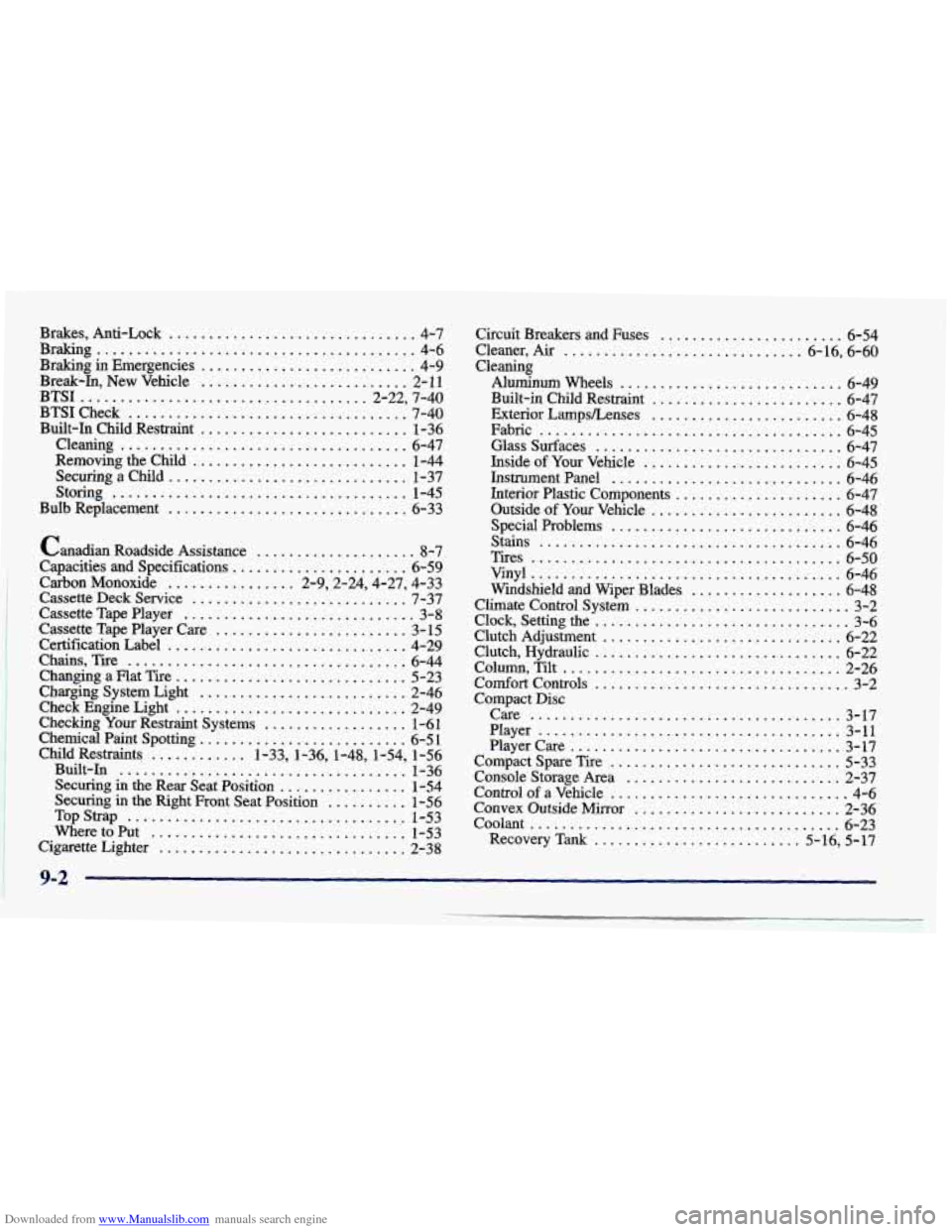
Downloaded from www.Manualslib.com manuals search engine Brakes. Anti-Lock ............................... 4-7
Braking in Emergencies
........................... 4-9
Break-In. New Vehicle
.......................... 2-11
Built-In Child Restraint
.......................... 1-36
Cleaning
.................................... 6-47
Removing the Child
........................... 1-44
Securing a Child
.............................. 1-37
Bulb Replacement
.............................. 6-33
........................................ Brdcing 4-6
BTSI
.................................... 2-22. 7-40
BTSICheck
................................... 7-40
..................................... Storing 1-45
Canadian Roadside Assistance
.................... 8-7
Capacities and Specifications
...................... 6-59
Carbon Monoxide
................ 2.9.2.24.4.27. 4.33
Cassette Deck Service
........................... 7-37
Cassette Tape Player
............................. 3-8
Cassette Tape Player Care ........................ 3- 15
Certification Label
.............................. 4-29
Chains. Tire
................................... 6-44
Changing a Hat Tire
............................. 5-23
Charging System Light
.......................... 2-46
Check Engine Light
............................. 2-49
Checking
Your Restraint Systems .................. 1-61
Chemical Paint Spotting
.......................... 6-51
Child Restraints
............ 1.33.1.36.1.48.1.54. 1.56
Securing in the Rear Seat
Position ................ 1-54
Securing
in the Right Front Seat Position .......... 1-56
Top Strap .................................. , . 1-53
Cigarette Lighter
............................... 2-38
Built-In
....,............................... l-36
Wheretoput ................................ l-53
Circuit Breakers and Fuses ....................... 6-54
Cleaning Cleaner. Air .............................. 6.16. 6.60
Aluminum Wheels
............................ 6-49
Built-in Child Restraint
........................ 6-47
Exterior LampsLenses
........................ 6-48
Glass Surfaces
............................... 6-47
Inside
of Your Vehicle ......................... 6-45
Instrument Panel
............................. 6-46
Interior Plastic Components
..................... 6-47
Outside
of Your Vehicle ........................ 6-48 .
Special Problems ............................. 6-46
Windshield and Wiper Blades
................... 6-48
Climate Control System
........................... 3-2
Clock, Setting the
................................ 3-6
Clutch Adjustment
.............................. 6-22
Clutch, Hydraulic
............................... 6-22
Column, Tilt
................................... 2-26
Comfort Controls
................................ 3-2
Fabric
...................................... 6-45
...................................... Stains 6-46
Tires
....................................... 6-50
Vinyl 6-46 .......................................
Compact Disc
Care
....................................... 3-17
Player 3-11 ......................................
Player Care .................................. 3-17
Compact Spare Tire
............................. 5-33
Console Storage Area
........................... 2-37
Control
of a Vehicle .............................. 4-6
Convex Outside Mirror
.......................... 2-36
Recovery
Tank .......................... 5-16, 5-17
Coolant ....................................... 6-23
9-2